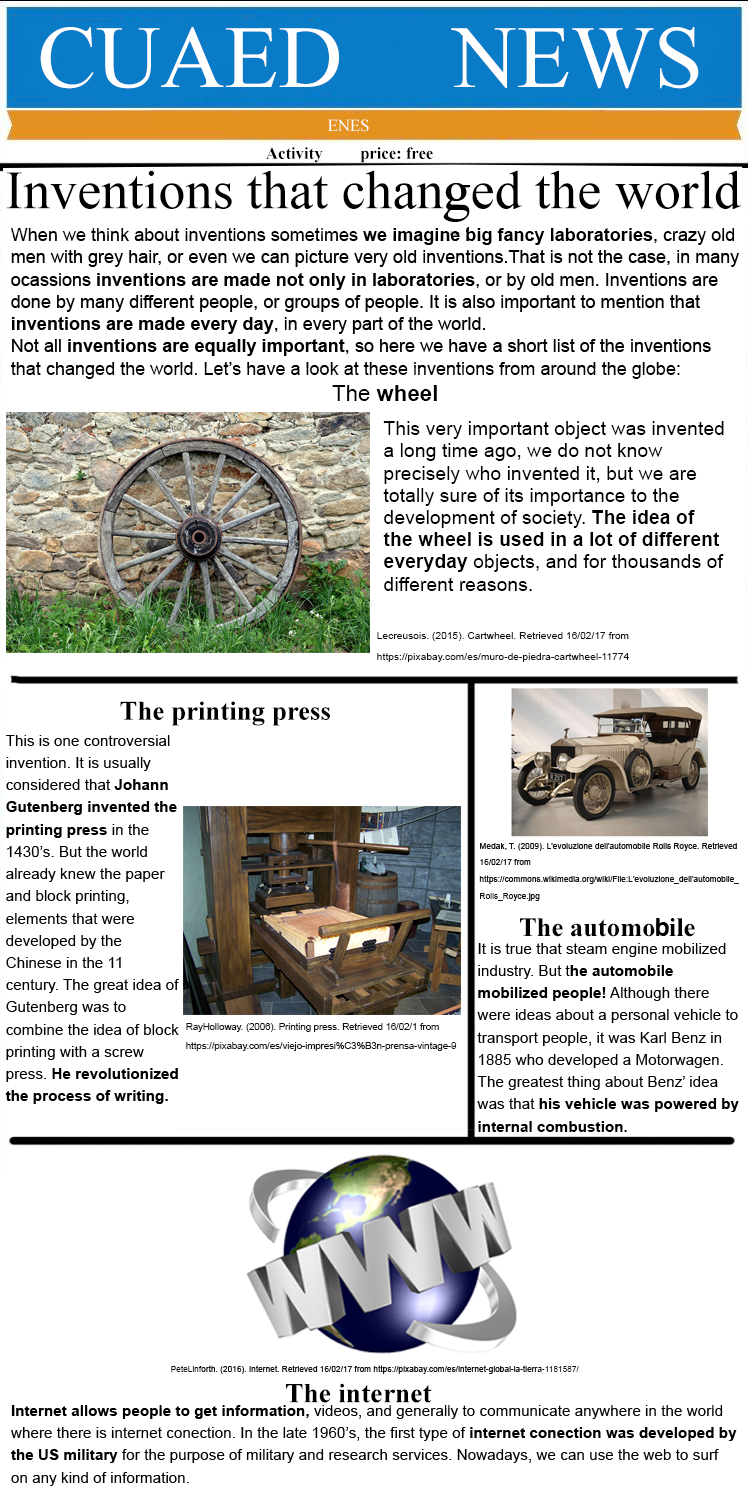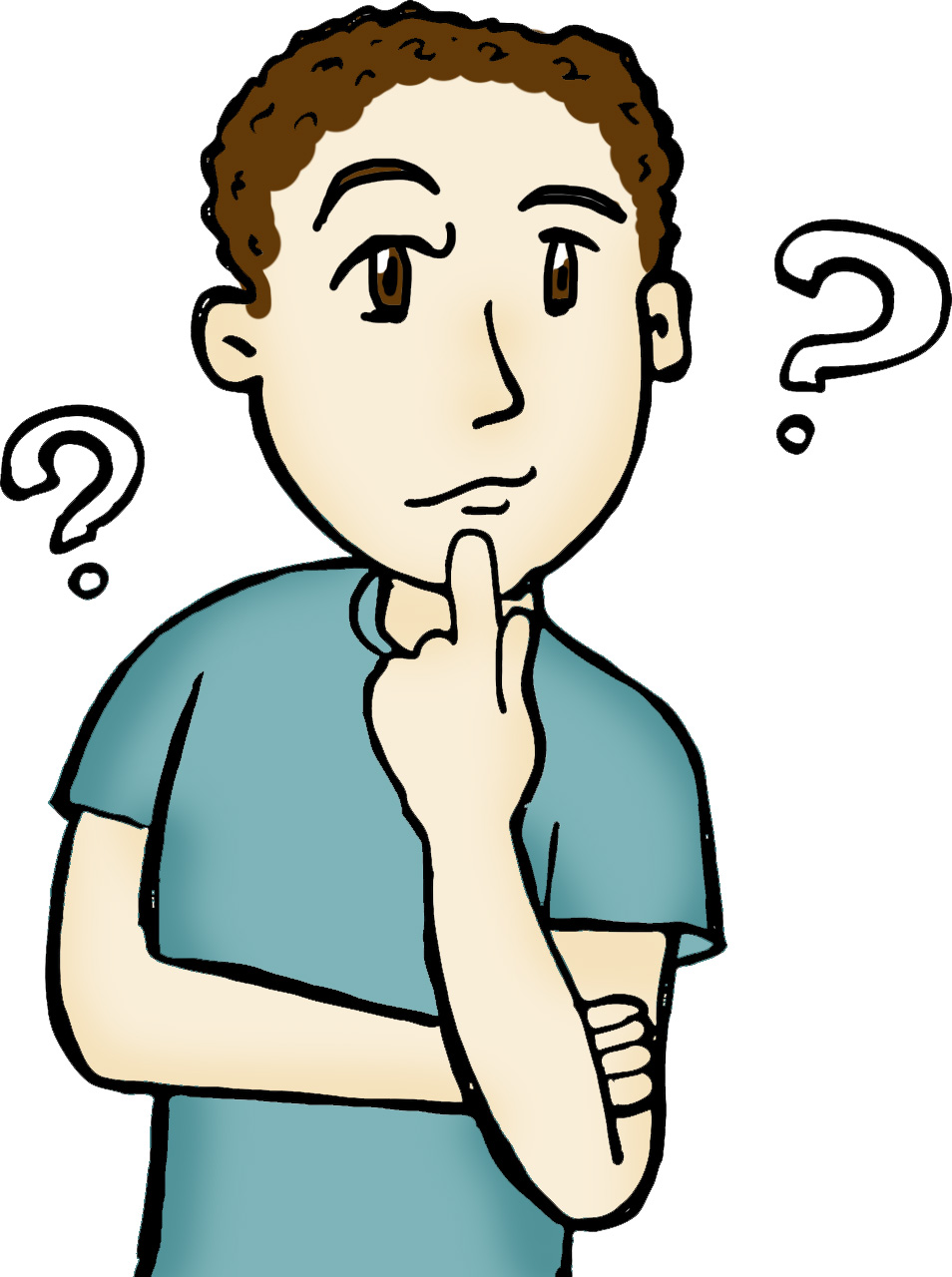How much do you know about inventions?

Experimenter Publishing. (2008). Science and Invention Nov 1928 Cover 2. Retrieved 16/02/17 from https://en.wikipedia.org/wiki/File:Science_and_Invention_Nov_1928_Cover_2.jpg
We will travel around the world and time to learn more about the most important and the newest discoveries, inventions and their authors. On the linguistic aspect, we will learn about passive voice; What it is, how we form it when do we use it, and its difference to active voice.
By the end of this topic you will:
Apply the concept of passive voice in sentences in the context of discoveries and inventions around the globe.
Firstly, we are going, to begin with, the telephone.
Think about the importance of knowing about new things, so, tell us about yourself.

Read the following short texts about the inventions.

Alles. (2016). Teléfono de la vendimia. Retrieved 16/02/17 from https://pixabay.com/es/tel%C3%A9fono-de-la-vendimia-tel%C3%A9fono-1750817/
The invention of the telephone was done by a group of individuals, from many different companies. However, it is believed that the phone was invented by Alexander Graham Bell in 1875 with the help of his friend Thomas A. Watson.

Anders. (2006). Mobile pone evolution. Retrieved 16/02/17 from https://commons.wikimedia.org/wiki/File:Mobile_phone_evolution.jpg
A mobile phone is a portable telephone that can make and receive calls over a radio frequency while the user is moving around a telephoned serviced area. The first mobile phone was created by Martin Cooper, a researcher from Motorola in 1973. The first phone call was made to John F Mitchel. It was until 1980 were when the first commercial mobile phones were sold. Do you have a mobile phone?

Dambrāns, K. (2014). iPhone 6 vs iPhone 6 Plus vs iPhone 5S. Retreived 16/02/17 from https://www.flickr.com/photos/janitors/15707819731
The first mobile phone with smart devices incorporated was developed by IBM in 1992, but it was not very popular. It was until 1994 that the first commercially produced Smartphone was introduced by the company Simon Personal Communicator. Emails and faxes were received by the Simon, the name of the first Smartphone.
As you can see, we’re talking about one of the most incredible inventions of our time, the phone.
Now look at the following sentences taken from the texts:

The
telephone
was
invented
by
Alexander
Graham
Bell
in
1875
This sentence is written in passive voice, we recognize the passive voice by looking at different elements, for example the subject is at the end of the sentence.
The
first
phonecall
was
made
to
John
F.
Mitchel
Another important element of a passive voice sentence is that we use the verb to be and the participle of another verb.
The
smartphone
was
introduced
by
the
company
Simon
personal
Communicator
One of the key features of the passive voice is that the first element in the sentence is the OBJECT or the element that is being affected by the verb.
Read the following scrambled sentences and put them in the correct order.
Look at the following explanation that will give you more detailed information.
Read the following short texts about the inventions.
What is there to know about passive voice?
The main idea behind a passive voice sentence is the emphasis we give to the object or action that we do. For example:
a. The light bulb was invented by Thomas A. Edison.
We emphasize the object/action by putting them in first place in a sentence. In (a) we say that the light bulb and not the telephone is what Thomas A. Edison invented.
b. Light bulbs are made of glass
Sometimes the subject of an action is not important or relevant for the sentence like in (b). In those cases where the subject is not relevant we can use passive voice.
As we previously said, the key factor of passive voice is that we emphasize the object/action of a sentence and NOT the subject. For this reason is that we make changes to the verbs.
One important characteristic about passive voice sentences is the use of the verb to be and the use of another verb in the participle form.
The verb to be indicates the tense. Look at the examples:
c. Penicillin was invented by the Scottish scientist Ian Fleming
d. Penicillin is used today to cure diseases like pneumonia.
In both sentences (c) and (d) the verb to be is used to form passive voice. In (c) we can see the verb to be is in past form, so we have a past passive voice.
In (d) the verb to be is the present tense, so we have a present passive voice.
When we say main verbs, we refer to the action verbs.
In concept 2 we mentioned that the verb to be indicates the tense: past, present, etc.
The action verb expresses the activity performed. Look at the sentences:
c. Penicillin was invented by the Scottish scientist Ian Fleming
d. Penicillin is used today to cure diseases like pneumonia.
In (c) and (d) the main verbs invent and use are used in their participle form.
It is actually pretty easy follow this steps:
1. The first element must be the element affected by the verb.
2. The verb must contain the verb to be AND another verb in participle.
3. If you see a by after the verb that means your subject.
4. If you do not have by, then the subject is absent
To make correct passive voice sentences, it is necessary to know verbs.
Did you match the verbs correctly? Excellent! In the passive voice, it is critical to identify the proper form of the verbs.

Sometimes it is difficult to mention the name of the “inventor” because there are many people involved. In other occasions, someone takes credit for an invention by just adding or making a crucial change to the object to make it more popular. In any case, sometimes designs impacts our daily lives. Which invention do you find most important?

The following sentences on most important inventions were taken from the previous text.
What is the tense?
The basic tenses in English are simple past, simple present, simple future. Passive voice is not precisely a new tense, passive voice is just another way to express things by putting emphasis on the object/action of the sentence. The correct form of passive voice needs the verb to be and the participle of the verb.
What about the negative and interrogative?
As with other tenses, it is important to identify how to use the negative and the interrogative form. Here you will find a brief explanation:

Regularly negative forms are expressed through the use of NOT. Look at the example:
a. Fire was NOT discovered by the modern man.
b. Regular books are NOT read by new generations who prefer e-books.
The first example is a past passive sentence, and we know it because the verb to be is in past. On the contrary the second sentence is in present passive, the verb to be is in the present tense.
As you can see the particle NOT is placed right before the auxiliary (to be) and before the main action verb in participle.
It is possible to find them in contractions such as:

As in any other interrogative form, the auxiliary plays an important role in questions. It MUST BE placed in first position:
c. Was penicillyn discovered in 2001?
d. Is Facebook used by millions of people?
In the examples in (c) and (d) you can see that the auxiliary in first position makes possible to have an interrogative form of a sentence.
Activity 1
In this topic, you are learning about discoveries, inventions and passive voice.
The following short text will help you analyse the importance of discoveries and inventions used by children.
In this activity, you will identify and analyse the importance of passive voice to emphasise the object/action in sentences.
You will read about inventions and discoveries that are used by children.
To start, match the picture to the appropriate vocabulary.
vocabulary.
After reading it, based on its content, choose the best heading for the paragraphs.
Activity 2
To continue with the topic, we will discuss one of the modern inventions used by most of the people around the world, Facebook.
In this audio, you will listen to someone talking about Facebook in his daily life. Remember to make notes that help you identify relevant information.
To begin with, read the following questions. Then decide if the statements are True (T) or False (F) by choosing the best option. You can know your score at the end of the exercise.
Listen to Jim talking about his use of social networking.

Finally, decide if the statements are True (T) or False (F) by choosing the correct option. You can know your score at the end of the exercise.

Activity 3
Social networks are undoubtedly the invention of our time. But what do you know about their inventors?
Start by searching for information about the inventors of WhatsApp and Facebook. Keep in mind that the data has to answer these questions, at least:
a) Who invented it?
b) When was it invented?
c) How did they have the idea
d) Why is it important?
Then, using the information you found about the social networks WhatsApp and Facebook, write a text (100-120 words) about ONLY ONE of the social networks,(Facebook or WhatsApp). Don’t forget to use the present and past passive voice. If you have any question, you can always check the previous sections to clarify.
Follow the guidelines:
a) What will you talk about?
b) Why did you choose this invention?
c) What’s important about the invention?
d) Who invented it and when was it invented?
e) How much do you use it?
f) If you did not have this social network your life would be different because…
Example:
Twitter was created by Evan Williams in the USA, in 2009. It was thought to be an easy way to communicate using mobile phones or tablets. However, it turned out to be readily accepted worldwide that the inventor decided to collaborate with Samsung. They made a free app linked to big telephone company's value, so Twitter time uses a phone's credit.
Check the following rubrics to organize your text. It will also help you to evaluate yourself.

Activity 4
In this exercise, you will give your opinion for 3 minutes about the most important discovery in your opinion. In your talk, you must make use of passive voice and active voice as necessary. Remember that if you have any question, you can always check the previous sections on this module.
Suggestions for your file:
a) It is a good idea to prepare the information you want to talk about. Firstly, answer these questions:
1. What will you talk about?
2. Why did you choose this invention
3. What’s important about the invention?
4. Who invented it and when was it invented.
5. How much do you use it?
6. a) If you didn't have this social network your life would be different because…
b) Write a paragraph of what you want to talk about. Do not forget to verify grammar and vocabulary.
c) Practice saying your text a couple of times before recording it. When you record it, you will feel more confident.
Recording characteristics
1) The file must be 3 minutes minimum.
2) You should consider the organisation given in the guidelines.
3) You must be fluent in the audio file.
4) Pronounce correctly basic elements of the English language such as past tenses.
In the following link, you can watch a video about who invented the Internet and why. Pay attention to the use of Passive Voice. It can help you to do your recording.
Once you are ready, you will record your speech. After that, listen to it and evaluate yourself using the rubrics. Based on the rubrics decide how well you did in this exercise.
The following exercises will help you evaluate how much you learned about the characteristics and use of passive voice.
• British Council (2016). Active and passive voice. Retrieved 11/11/2016 from https://learnenglish.britishcouncil.org/es/english-grammar/verbs/active-and-passive-voice
• English-Hilfen.de. (n.d.). Passive voice. English gramamar exercises.
Retrieved 11/11/2016 from
http://www.englisch-hilfen.de/en/exercises_list/passiv.htm
• Attenbury, J. (2017). Top inventions for kids. How stuff works. Retrieved 07/02/2017 from http://science.howstuffworks.com/innovation/inventions/5-inventions-for-kids.htm